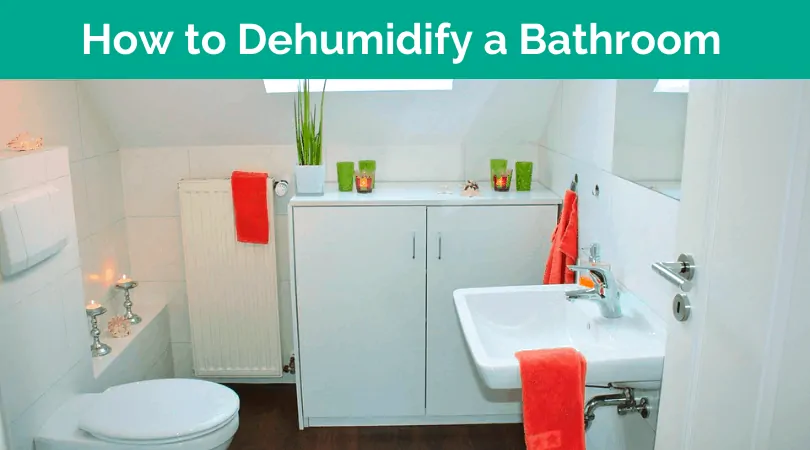Humidity in the bathroom can come from hot showers and even hand-washing. It can affect your décor and your bathroom furniture, but it can also lead to the development of mold and mildew.
7 Ways to Dehumidify Your Bathroom
1. Open the Door And Windows.
After you finish your shower, make sure to open the windows and door to let cool air inside the bathroom. That way, you can prevent condensation on the walls and windows and damaging furniture and paint.
Keep the doors open if you live in a humid area and already use a whole-house dehumidifier.
2. Turn the Vent On
If you have a windowless bathroom, regulating humidity might be trickier. In that case, always turn the ventilation on before you start showering. The exhaust fan can help you dehumidify the bathroom.
3. No Exhaust Fan? Get a Suitable Dehumidifier.
Bathroom dehumidifiers suck humid air up, then dry it out and use a fan to disperse the air back into the room. Place the device away from the shower to get the best results and ensure there are no risks of electric shocks.
While it is safe to leave a dehumidifier on while you are taking a shower, you can also switch it on after you finish.
Keep an eye on the dehumidifier’s water tank, and empty it regularly to ensure its best performance. Most dehumidifiers have an automatic shut-off option, meaning they will stop working when the tank is full. So, drain the tank, wipe it off if there is water, and turn it on again.
Do you need a dehumidifier?
Buying a bathroom dehumidifier can be excellent if your bathroom doesn’t have windows or an exhaust fan. Also, it won’t make much difference if the exhaust fan isn’t powerful.
Because it can take a lot of time to exhaust moist air, the risk of condensation and mold is higher. High humidity levels for a long time will result in unpleasant odors and mold development.
Additionally, if you or some of your family members suffer from respiratory issues, the long-term use of a wet bathroom can worsen the conditions.
Eventually, the odors and mold can spread around your apartment, especially if you live in a smaller space.
4. Deal with Condensation
You can prevent condensation on windows if you choose to double-glaze them. If only one coat is on the window, it will be colder. Thus the hot air from the shower will create more condensation.
Thus, consider double-glazed windows for your bathrooms.
5. Maintain the Dry Bathroom
After a shower, always wipe the excess water from the floor and walls. Remember to wipe the mirror as well.
You can also buy a mirror with a defogger or get a defogger separately.
Dry Towels Outside
Some people have a habit of drying their towels inside the bathroom. They put it on the heater or hang it on the door to air dry. However, to prevent excessive humidity, you should avoid keeping wet things in the bathroom.
The moisture from your clothes and towels will end up in the air, making the bathroom even more humid.
It is better to dry towels outdoors.
6. Take Shorter Showers
If you cannot maintain optimal humidity in the bathroom, consider taking shorter showers. Also, shower with warm water instead of showering with hot water. Changing showering habits and using a dehumidifier can make a difference very quickly.
7. No Carpets
Avoid carpets in the bathroom as they trap moisture. Carpets take time to dry, even more than clothes. You can use linoleum or throw rugs to add a bit of warmth.
What causes bathroom mold?
Wet areas are prone to mold development. So, if the surface stays wet for a while, mold spores multiply and spread across other surfaces. It is especially prone to paper, wood, fabric, and ceiling tiles.
Risks of Mold in the Household
Mold isn’t only an aesthetic issue. Mold spores can cause issues even for healthy people.
People with lung problems and immunity conditions should be extra careful about humid areas.
Mold is severely hazardous for people with asthma or other respiratory diseases.
Additionally, mold can ruin your furniture and walls and raise costs for repairs.
Luckily, there are ways to prevent it. The most effective way to regulate humidity is to use a dehumidifier in the bathroom.
The bottom line
Excessive humidity in any room can be hazardous in many ways. Because of it, mold can develop quickly and affect your health and furniture.
Using a dehumidifier in the bathroom can dry the air and prevent the negative consequences of high humidity. But, to achieve the best results, you can open the windows, turn on the exhaust fan, keep the bathroom dry, and take shorter and colder showers.
My name is Theresa Clark. I am an engineer and air quality specialist.
